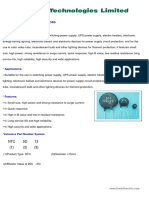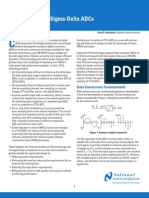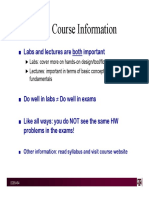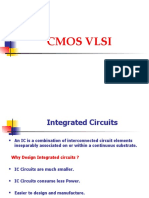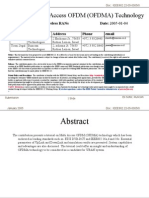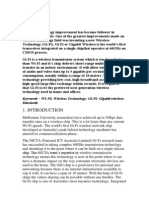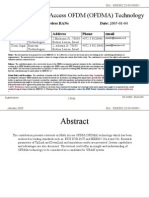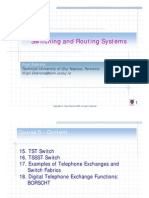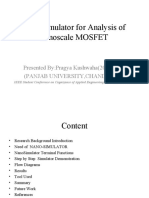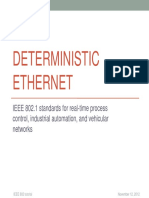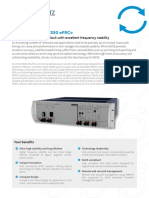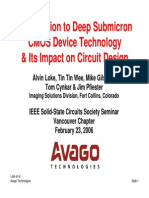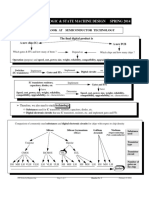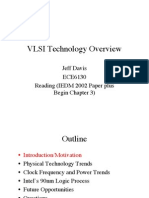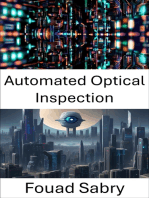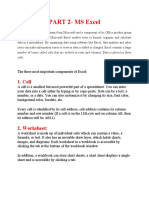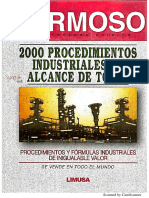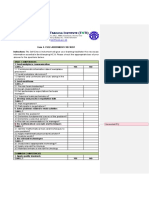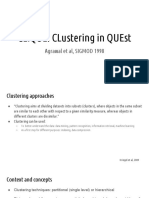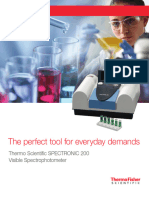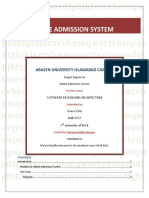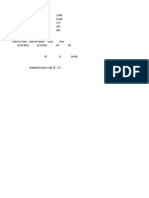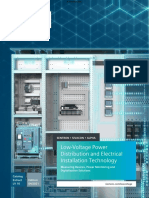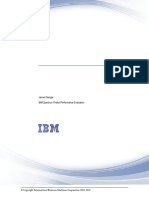EECS 247 Analog-Digital Interface Integrated Circuits © 2010
EECS 247 Analog-Digital Interface Integrated Circuits © 2010
Uploaded by
Muhammad FaisalCopyright:
Available Formats
EECS 247 Analog-Digital Interface Integrated Circuits © 2010
EECS 247 Analog-Digital Interface Integrated Circuits © 2010
Uploaded by
Muhammad FaisalOriginal Title
Copyright
Available Formats
Share this document
Did you find this document useful?
Is this content inappropriate?
Copyright:
Available Formats
EECS 247 Analog-Digital Interface Integrated Circuits © 2010
EECS 247 Analog-Digital Interface Integrated Circuits © 2010
Uploaded by
Muhammad FaisalCopyright:
Available Formats
EECS 247
Analog-Digital Interface
Integrated Circuits
© 2010
Instructor: Haideh Khorramabadi
UC Berkeley
Department of Electrical Engineering and
Computer Sciences
Lecture 1: Introduction
EECS 247 Lecture 1: Introduction © 2010 H.K. Page 1
Instructor‟s Technical Background
• Ph.D., EECS department -UC Berkeley 1985, advisor Prof. P.R. Gray
– Thesis topic: Continuous-time CMOS high-frequency filters
• Industrial background
– 11 years at ATT & Bell Laboratories, N.J., in the R&D area as a circuit designer
• Circuits for wireline communications: CODECs, ISDN, and DSL including
ADCs (nyquist rate & over-sampled), DACs, filters, VCOs
• Circuits intended for wireless applications
• Fiber-optics circuits
– 3 years at Philips Semiconductors, Sunnyvale, CA
• Managed a group in the RF IC department- developed ICs for CDMA &
analog cell phones
– 3 years @ Broadcom Corp. – Director of Analog/RF ICs in San Jose, CA.
• Projects: Gigabit-Ethernet, TV tuners, and DSL circuitry
– Currently consultant for IC design
• Teaching experience
– Has taught/co-taught EE247 @ UCB since 2003
– Instructor for short courses offered by MEAD Electronics
– Adjunct Prof. @ Rutgers Univ., N.J. : Taught a graduate level IC design course
EECS 247 Lecture 1: Introduction © 2010 H.K. Page 2
Administrative Issues
• Course web page:
http://inst.eecs.berkeley.edu/~EE247/fa10
– Course notes will be uploaded on the course
website prior to each class
– Announcements regarding the course will be
posted on the home page, please visit course
website often
– Homeworks & due dates are posted on the course
website
EECS 247 Lecture 1: Introduction © 2010 H.K. Page 3
Office Hours & Grading
• Office hours:
– Tues./Thurs. 4 to 5pm @ TBD (unless otherwise
announced in the class)
– Extra office hours by appointment
– Feel free to discuss issues via email:
haidehk@eecs.berkeley.edu
• Course grading:
– Homework/project 50%
– Midterm 20% (tentative date: Oct. 28)
– Final 30%
EECS 247 Lecture 1: Introduction © 2010 H.K. Page 4
Prerequisites & CAD Tools
• Prerequisites
– Basic course in signal processing (Laplace and z-
transform, discrete Fourier transform) i.e. EE120
– Fundamental circuit concepts i.e. EE105 and
EE140
• CAD Tools:
– Hspice or Spectre
– Matlab
EECS 247 Lecture 1: Introduction © 2010 H.K. Page 5
Analog-Digital Interface Circuitry
Analog Output Analog Input
Analog World
Analog/Digital Digital Digital/Analog
Interface 001 Processor 1001 Interface
110 1010
010 0010
• Naturally occurring signals are analog
• To process signals in the digital domain
Need Analog/Digital & Digital/Analog interface circuitry
Question: Why not perform the signal processing in the analog domain only
& thus eliminate need for A/D & D/A?
EECS 247 Lecture 1: Introduction © 2010 H.K. Page 6
What is ft ?
ii
• ft transition frequency io
gmvgs
• Freq. where short-circuit ii
vgs ~ Cgs io
M1
common-source current vin ~
gain AI ~1
Ac small signal model
• Significance of ft : For a
given technology single
device ftmax with io ii gm sC iio gm
gs i sCgs
minimum channel length io 1 2 f gm
t C
is a measure of max. ii gs
Substituting for gm and Cgs :
achievable circuit speed: n VGS Vt
example in a given ft 1.5
2 L*
technology maximum where * 2 for L 1 for L 1 2 * 1
achievable bandwidth for where L is channel length
ftmax VGS Vt
max
an opamp ~ ftmax /10 & Lmin
EECS 247 Lecture 1: Introduction © 2010 H.K. Page 7
CMOS Technology Evolution versus Time
ft [GHz] 10n
65n
100 0.13u 45n
0.1u
0.25u
0.18u
0.35u
10 0.6u
0.8u
1u
1.5u
1 2u
3u
6u Year
75 80 85 90 95 ’00 ’05 ’10
ft for NMOS @ (VGS - Vth = 0.5V )
*Ref: Paul R. Gray UCB EE290 course „95
International Technology Roadmap for Semiconductors, http://public.itrs.net
EECS 247 Lecture 1: Introduction © 2010 H.K. Page 8
CMOS Device Evolution
Progression from 1975 to 2005
• Minimum feature sizes ~X1/100
• Max. cut-off frequency ft ~X300
• Minimum size device area ~1/L2
• Number of interconnect layers ~X8
In the past 35 years, evolution of CMOS technology has
resulted in drastic increase in circuit speed and density
Note: Moore‟s Law every 18months # of transistors per sq-inch
increases x2
EECS 247 Lecture 1: Introduction © 2010 H.K. Page 9
Impact of CMOS Scaling on
Digital Signal Processing
Direct beneficiary of VLSI technology down scaling
– Digital circuits deal with “0” & “1” signal levels only
Not sensitive to “analog” noise
– Si Area/function reduced drastically due to
• Shrinking of feature sizes
• Increase in # of metal levels for interconnections (currently
>8 metal level v.s. only 1 in the 1970s)
– Enhanced functionality & flexibility
– Amenable to automated design & test
– “Arbitrary” precision
– Provides inexpensive storage capability
EECS 247 Lecture 1: Introduction © 2010 H.K. Page 10
Analog Signal Processing Characteristics
• Sensitive to “analog” noise
• Has not fully benefited from technology down scaling:
– Supply voltages scale down accordingly
Reduced voltage swings more challenging analog
design
– Reduced voltage swings requires lowering of the
circuit noise to keep a constant dynamic range
Higher power dissipation and chip area
• Not amenable to automated design
• Extra precision comes at a high price
• Rapid progress in DSP has imposed higher demands
on analog/digital interface circuitry
Plenty of room for innovations!
EECS 247 Lecture 1: Introduction © 2010 H.K. Page 11
Cost/Function Comparison
DSP & Analog
• Digital circuitry: Fully benefited from CMOS device scaling
– Cost/function decreases by ~29% each year
Cost/function X1/30 in 10 years*
• Analog circuitry: Not fully benefited from CMOS scaling
– Device scaling mandates drop in supply voltages
threaten analog feasibility
Cost/function for analog ckt almost constant or increase
Rapid shift of function implementation from processing in
analog domain to digital & hence increased need for A/D &
D/A interface circuitry
*Ref: International Technology Roadmap for Semiconductors, http://public.itrs.net
EECS 247 Lecture 1: Introduction © 2010 H.K. Page 12
Digitally Assisted Analog Circuitry
• Analog design has indeed benefited
from the availability of inexpensive on-
chip digital capabilities
• Examples:
– Compensating/calibrating ADC & DAC
inaccuracies
– Automatic frequency tuning of filters &
VCOs
– DC offset compensation
EECS 247 Lecture 1: Introduction © 2010 H.K. Page 13
Analog Digital Interface Circuitry
Example: Digital Audio
Analog Input
• Goal-Lossless archival and
transmission of audio signals
Analog
• Circuit functions:
Preprocessing
– Preprocessing
• Amplification A/D
• Anti-alias filtering Conversion
– A/D Conversion
• Resolution16Bits DSP
– DSP
• Storage
• Processing (e.g. recognition) D/A
Conversion
– D/A Conversion
– Postprocessing Analog
• Smoothing filter Postprocessing
• Variable gain amplification
Analog Output
EECS 247 Lecture 1: Introduction © 2010 H.K. Page 14
Example: Typical Dual Mode Cell Phone
Contains in integrated form the following interface circuitry:
• 4 RX filters
• 3 or 4 TX filters
Dual Standard, I/Q
• 4 RX ADCs
• 2 TX DACs
Audio, Tx/Rx power
• 3 Auxiliary ADCs
control, Battery charge
• 8 Auxiliary DACs control, display, ...
Total: Filters 8
ADCs 7
DACs 12
EECS 247 Lecture 1: Introduction © 2010 H.K. Page 15
Areas Utilizing Analog/Digital Interface Circuitry
• Communications
– Wireline communications
• Telephone related (DSL, ISDN,
CODEC)
• Television circuitry (Cable
modems, TV tuners…)
• Ethernet (Gigabit,
10/100BaseT…)
– Wireless
• Cellular telephone (CDMA,
Analog, GSM….)
• Wireless LAN (Blue tooth,
802.11a/b/g…..)
• Radio (analog & digital),
Television
• Personal Data Assistants
• Computing & Control
– Storage media (disk drives, digital
tape)
– Imagers & displays
EECS 247 Lecture 1: Introduction © 2010 H.K. Page 16
Areas Utilizing Analog/Digital Interface Circuitry
• Instrumentation
– Electronic test equipment
& manufacturing
environment ATEs
– Semiconductor test
equipment
– Physical sensors &
actuators
– Medical equipment
• Consumer Electronics
– Audio (CD, DAT, MP3)
– Automotive control,
appliances, toys
EECS 247 Lecture 1: Introduction © 2010 H.K. Page 17
UCB Graduate Level Analog Courses
EECS 247 - 240 - 242
• EECS 240
– Transistor level, building blocks such as opamps, buffers, comparator….
– Device and circuit fundamentals
– CAD Tools SPICE
• EECS 247
– Filters, ADCs, DACs, some system level
– Signal processing fundamentals
– Macro-models, large systems, some transistor level, constraints such as finite gain,
supply voltage, noise, dynamic range considered
– CAD Tools Matlab, SPICE
• EECS 242
– RF amplification, mixing
– Oscillators
– Exotic technology devices
– Nonlinear circuits
EECS 247 Lecture 1: Introduction © 2010 H.K. Page 18
Material Covered in EE247
• Filters
– Continuous-time filters
• Biquads & ladder type filters
• Opamp-RC, Opamp-MOSFET-C, gm-C filters
• Automatic frequency tuning techniques
– Switched capacitor (SC) filters
• Data Converters
– D/A converter architectures
– A/D converter
• Nyquist rate ADC- Flash, Pipeline ADCs,….
• Self-calibration techniques
• Oversampled converters
• Systems utilizing analog/digital interfaces
– Wireline communication systems- ISDN, XDSL…
– Wireless communication systems- Wireless LAN, Cellular
telephone,…
– Disk drive electronics
EECS 247 Lecture 1: Introduction © 2010 H.K. Page 19
Books (on reserve @ Eng. Library)
(NOT required to be purchased)
• Filters
– A. Williams and F. Taylor, Electronic Filter Design Handbook, 3rd edition, McGraw-Hill,
1995.
– W. Heinlein & W. Holmes, “Active Filters for Integrated Circuits”, Prentice Hall Int., Inc.
Chap. 8, 1974. Good reference for signal flowgraph techniques
– A. Zverev, Handbook of Filter Synthesis, Wiley, 1967.
A classic; focus is on passive ladder filters. Tables for implementing ladder filters (replaces
a CAD tool).
• Data Converters
– R. van de Plassche, Integrated Analog-to-Digital and Digital-to-Analog Converters, 2nd
edition, Kluwer, 2003.
– B. Razavi, Data Conversion System Design, IEEE Press, 1995.
– S. Norsworthy et al (eds), Delta-Sigma Data Converters, IEEE Press, 1997.
• General
– Gray, Hurst, Lewis, Meyer, Analysis & Design of Analog Integrated Circuits, Wiley 2001.
– Johns, Martin, Analog Integrated Circuit Design, Wiley 1997.
Note: List of relevant IEEE publications is posted on the course website under
“Reading Material”. Some will be noted as mandatory reading and the rest optional
EECS 247 Lecture 1: Introduction © 2010 H.K. Page 20
Introduction to Filters
• Filtering Provide frequency selectivity and/or phase shaping
– Oldest & most common type of signal processing
Signal Signal
Amplitude Amplitude
0 freq. 0 freq.
Lowpass
Filter Vout
Vin
EECS 247 Lecture 1: Introduction © 2010 H.K. Page 21
Introduction to Filters
• Typical filter applications:
– Extraction of desired signal from many
(radio, TV, cell phone, ADSL…..)
– Separating signal and noise
– Anti-aliasing or smoothing
– Phase equalization
– Amplifier bandwidth limitations
EECS 247 Lecture 1: Introduction © 2010 H.K. Page 22
Ideal versus Practical Filters
Example: Lowpass Filter
• Ideal filter • Practical filter
– Flat magnitude response in – Ripple in passband
the passband magnitude response
– Brick-wall transition – Limited rejection of out-of-
– Infinite level of rejection of band signals
out-of-band signals
H jf H jf
frequency
frequency
Ideal Lowpass Brick-Wall Filter More Practical Filter
EECS 247 Lecture 1: Introduction © 2010 H.K. Page 23
Simplest Filter
First-Order Lowpass RC Filter
R
(Z=R) C
(Z=1/sC)
Steady-state frequency response:
Vout ( s ) 1 1
H( s ) sC
Vin ( s ) R 1 1 RCs
sC
1 1
with o H( s )
s
RC 1
o
EECS 247 Lecture 1: Introduction © 2010 H.K. Page 24
S-Plane Poles and Zeros
1
s-plane (pzmap):
H (s) j
s
1
o
p o
Pole:
p=-o s
Zero: z
1 1
H (s)
2
1 j
o 1
2
o
EECS 247 Lecture 1: Introduction © 2010 H.K. Page 25
Magnitude Response Characteristics
• Typically, magnitude response is plotted as a function of frequency and
in terms of decibel [dB]
1
2
20 log H ( s ) 20 log 10 log 1
2
2
o
1
2
o
o 20 log H ( s ) 3dB
• The frequency where magnitude response changes by 3dB is called the
corner or in the case of lowpass filter cut-off frequency
EECS 247 Lecture 1: Introduction © 2010 H.K. Page 26
Simplest Filter
First-Order Lowpass RC Filter Example
R1=150 kOHM C1
10pF
Steady-state frequency response:
Vout ( s ) 1
H( s )
s
Vin( s ) 1
o
1
with o 2 100kHz
RC
EECS 247 Lecture 1: Introduction © 2010 H.K. Page 27
Filter Frequency Response
Bode Plot
H ( s j ) 0 1
0
Magnitude (dB)
H ( s j ) 1/ 2
-20
-40
0
-60
-100dB!
H ( s j ) 0 -80
-100
-120
0
Asymptotes:
Phase (deg)
-30
- 20dB/dec magnitude rolloff
- 90degrees phase shift per 2 decades -60
-90
1 2 3 4 5 6 7 8 9 10
10 10 10 10 10 10 10 10 10 10
Frequency [Hz]
Question:
can we really get 100dB attenuation at 10GHz?
EECS 247 Lecture 1: Introduction © 2010 H.K. Page 28
First-Order Lowpass RC Filter
Including Parasitics
Cp=10fF
R1=150kOHM
C1
10pF
1 1
1 sRCP Pole : p
R C CP
H ( s) RC
1 sRC C P Zero : z
1
RC P
EECS 247 Lecture 1: Introduction © 2010 H.K. Page 29
Filter Frequency Response
0
Magnitude (dB)
-20
H ( j ) 0 1 -40
CP
H ( j )
-60
C CP -80
0
CP
Phase (deg)
C -45
103
60dB
-90
2 3 4 5 6 7 8 9 10
10 10 10 10 10 10 10 10 10
Frequency [Hz]
• Beware of important parasitics & include them in the model …
EECS 247 Lecture 1: Introduction © 2010 H.K. Page 30
Dynamic Range & Electronic Noise
• Dynamic range is defined as the ratio of maximum
possible signal handled by a circuit and the minimum
useful signal
– Maximum signal handling capability usually determined by
maximum possible voltage swings which in turn is a
function of supply voltage & circuit non-linearity
– Minimum signal handling capability is normally
determined by electronic noise
• Amplifier noise due to device thermal and flicker noise
• Resistor thermal noise
• Dynamic range in analog ckts has direct implications
for power dissipation
EECS 247 Lecture 1: Introduction © 2010 H.K. Page 31
Analog Dynamic Range
Example: First Order Lowpass Filter
• Once the poles and zeroes of the analog filter
transfer function are defined then special attention
must be paid to the actual implementation
• Of the infinitely many ways to build a filter with a
given transfer function, each of those combinations
result in a different level of output noise!
• As an example noise and dynamic range for the 1st
order lowpass filter will be derived
EECS 247 Lecture 1: Introduction © 2010 H.K. Page 32
First Order Filter Noise
• Capacitors are
noiseless
• Resistors have thermal R
vIN vOUT
noise
– This noise is uniformly
distributed in the C
frequency domain from
dc to infinity
– Frequency-independent
noise is called “white
noise”
EECS 247 Lecture 1: Introduction © 2010 H.K. Page 33
Resistor Noise
• Resistor noise
characteristics
– A mean value of zero R
– A mean-squared value vIN vOUT
ohms
vn2 4kBTr Rf C
measurement bandwidth (Hz)
Volts2
absolute temperature (°K)
Boltzmann’s constant = 1.38e-23 J/°K
EECS 247 Lecture 1: Introduction © 2010 H.K. Page 34
Resistor Noise
• Theoretically, resistor rms
noise voltage in a 10Hz band
centered at 1kHz is the same
as resistor rms noise in a R
10Hz band centered at 1GHz vIN vOUT
• Resistor noise spectral
density, N0, is the rms noise
C
per Hz of bandwidth:
vn2
N0 4k BTr R
f
EECS 247 Lecture 1: Introduction © 2010 H.K. Page 35
Resistor Noise
Good numbers to memorize:
• N0 for a 1k resistor at room
temperature is 4nV/Hz
R
• Scaling R, vIN vOUT
– A 10M resistor gives 400nV/Hz
– A 50 resistor gives 0.9nV/Hz
C
• Or, remember
kBTr = 4x10-21 J (Tr = 17 oC)
• Or, remember
kBTr /q = 26mV (q = 1.6x10-19 C)
EECS 247 Lecture 1: Introduction © 2010 H.K. Page 36
First Order Filter Noise
• To derive noise @ the output
node:
– Short circuit the input to
ground. R
– Resistor noise gives the filter a
- + vOUT
vIN
non-zero output when vIN=0 e
– In this simple example, both
the input signal and the C
resistor noise obviously have
the same transfer functions to
the output
– Since noise has random
phase, we can use any
polarity convention for a noise
source (but we have to use it
consistently)
EECS 247 Lecture 1: Introduction © 2010 H.K. Page 37
First Order Filter Noise
• What is the thermal noise of this R=8k
RC filter? vIN - + vOUT
e
• Let‟s ask SPICE!
Netlist: C=1nF
*Noise from RC LPF
vin vin 0 ac 1V
r1 vin vout 8kOhm
c1 vout 0 1nF 1
.ac dec 100 10Hz 1GHz o 2 2 0k H z
.noise V(vout) vin RC
.end
EECS 247 Lecture 1: Introduction © 2010 H.K. Page 38
Output Noise Spectral Density
100
Noise Spectral Density [nV/Hz]
20 kHz corner
10
N 0 4k BTr R
1 nV
8 4
Hz
nV
11.3
0.1 Hz
0.01
101 103 105 107 109 [Hz]
EECS 247 Lecture 1: Introduction © 2010 H.K. Page 39
Total Noise
• Total noise is what the display on a volt-meter connected to vo
would show!
• Total noise is found by integrating the noise power spectral
density within the frequency band of interest
• Note that noise is integrated in the mean-squared domain,
because noise in a bandwidth df around frequency f1 is
uncorrelated with noise in a bandwidth df around frequency f2
– Powers of uncorrelated random variables add
– Squared transfer functions appear in the mean-squared integral
f2
vo2 vn2 H( j ) 2df
f1
vo2 4kB T R H( 2 jf ) 2df
0
*Ref: “Analysis & Design of Analog Integrated Circuits”, Gray, Hurst, Lewis, Meyer- Chapter 11
EECS 247 Lecture 1: Introduction © 2010 H.K. Page 40
Total Noise
vo2 4kBTR H( 2 jf ) df
2
0
2
1 1
4kBTR df 4kBTR df 4kBTRx 1 tan 1 2 RCf
0
1 2 jfRC 0 1 2 fRC 2 2 RC 0
vo2 kBT
C
• This interesting and somewhat counter intuitive result means that even
though resistors are the components generating the noise, total noise is
determined by noiseless capacitors!
• For a given capacitance, as resistance goes up, the increase in noise
density is balanced by a decrease in noise bandwidth
EECS 247 Lecture 1: Introduction © 2010 H.K. Page 41
kT/C Noise
• kT/C noise is a fundamental analog circuit limitation
• The rms noise voltage of the simplest possible (first order) filter is
(kBT/C)1/2
• For 1pF capacitor, (kBT/C)1/2 = 64 V-rms (at 298°K)
• In our example C=1000pF gives 2 V-rms
• The noise of a more complex & higher order filter is given by:
(a x kBT/C)1/2
where a depends on implementation and features such as filter order
EECS 247 Lecture 1: Introduction © 2010 H.K. Page 42
Lowpass Filter Total Output Noise
100
Integrated Noise Voltage [ Vrms]
Noise Spectral Density [nV/Hz]
10
2Vrms
1
0.1
0.01
101 103 105 107 109 [Hz]
EECS 247 Lecture 1: Introduction © 2010 H.K. Page 43
Lowpass Filter Output Noise
• Note that the integrated noise essentially
stops growing above 100kHz for this lowpass
filter with f-3dB=20kHz
• Beware of faulty intuition which might tempt
you to believe that an 80, 1000pF filter has
lower total output noise compared to our
8000, 1000pF filter…
EECS 247 Lecture 1: Introduction © 2010 H.K. Page 44
Lowpass Filter Output Noise
100
Integrated Noise Voltage ( Vrms)
Noise Spectral Density (nV/Hz)
80 &1000pF 8000 & 1000pF
10
0.1
0.01
101 103 105 107 109 [Hz]
EECS 247 Lecture 1: Introduction © 2010 H.K. Page 45
Analog Circuit Dynamic Range
• Maximum voltage swing for analog circuits (assuming no inductors
are used!) can at most be equal to power supply voltage VDD
(normally is smaller)
1 VDD
• Assuming a sinusoid signal Vmax ( rms)
2 2
k T
• Noise for a filter Vn (rms ) a B
C
V (rms ) VDD C
D.R. max [V/V]
Vn (rms ) 8a k BT
Dynamic range in dB is:
C
20log10 VDD 75 [dB] with C in [pF]
a
EECS 247 Lecture 1: Introduction © 2010 H.K. Page 46
Analog Circuit Dynamic Range
• For integrated circuits built in modern CMOS
processes, VDD < 1.5V and C < 100pF
– D.R. < 98 dB (assuming a = 1)
• For printed-circuit board type circuits built with “old-
fashioned” 30V opamps and discrete capacitors of <
100nF
– D.R . < 140dB
– A 42dB advantage!
EECS 247 Lecture 1: Introduction © 2010 H.K. Page 47
Dynamic Range versus Number of Bits
• Number of bits and dynamic range in terms of dB are
related:
D.R. 1.76 6.02 N [dB] N number of bits
– see “quantization noise”, later in the course
• Hence
98 dB 16 Bits
140 dB 23 Bits
EECS 247 Lecture 1: Introduction © 2010 H.K. Page 48
Dynamic Range versus Power Dissipation
• Addition of each extra bit corresponds to 6dB extra dynamic range
• Increasing dynamic range by one bit 6dB less noise decrease in
noise power by 4x!
• This translates into 4x larger capacitors
• To keep speed constant (speed prop Gm/C): Gm must increase 4x
• Power dissipation is proportional to Gm increases by 4x(for fixed supply and
Vdsat)
In analog circuits with performance limited by thermal noise,
1 extra bit costs 4x extra power dissipation
E.g. 16Bit ADC at 200mW 17Bit ADC at 800mW
Do not overdesign the dynamic range of analog circuits!
EECS 247 Lecture 1: Introduction © 2010 H.K. Page 49
Noise & Dynamic Range Summary
• Thermal noise is a fundamental property of
(electronic) circuits
• In filters, noise is closely related to
– Capacitor size
• In higher order filters, noise is a function of C, filter
order, Q, and depends on implementation
• Operational amplifiers used in active filters can also
contribute significant levels of extra noise to overall
filter noise
• Reducing noise in most analog circuits is costly in
terms of power dissipation and chip area
EECS 247 Lecture 1: Introduction © 2010 H.K. Page 50
You might also like
- SOC Analyst Course Content v3Document16 pagesSOC Analyst Course Content v3Halil YapraklıNo ratings yet
- Win Server 2022 Performance Tuning GuidelinesDocument261 pagesWin Server 2022 Performance Tuning GuidelinesyoyoNo ratings yet
- Scaling Factors and Scaling ParametersDocument22 pagesScaling Factors and Scaling Parametersvirajitha159475% (4)
- EECS 247 Analog-Digital Interface Integrated Circuits © 2008Document24 pagesEECS 247 Analog-Digital Interface Integrated Circuits © 2008Hassan FarssiNo ratings yet
- Berkley LectureDocument25 pagesBerkley LectureSanjay Subba RaoNo ratings yet
- Scaling PDFDocument72 pagesScaling PDFMayank SinghNo ratings yet
- Lecture01 Ee620 IntroDocument18 pagesLecture01 Ee620 IntroPeygamberinizi SikiyimNo ratings yet
- W6 製程整合newDocument37 pagesW6 製程整合newcharlietu86No ratings yet
- NTC 5D 13 (1) (2) (3) : NSP Power Type NTC ThermistorsDocument5 pagesNTC 5D 13 (1) (2) (3) : NSP Power Type NTC ThermistorsKaveesha DinamiduNo ratings yet
- Four-Terminal Polycrystalline-Silicon Thin-Film Transistors With High-K HfO2 Dielectric On Glass SubstrateDocument2 pagesFour-Terminal Polycrystalline-Silicon Thin-Film Transistors With High-K HfO2 Dielectric On Glass Substrateaanya.2129No ratings yet
- Organic Thin Film TransistorsDocument38 pagesOrganic Thin Film TransistorsTabish ImranNo ratings yet
- Embedded Communications: Version 2 EE IIT, Kharagpur 1Document11 pagesEmbedded Communications: Version 2 EE IIT, Kharagpur 1ahamed100% (1)
- Welcome To EE 130/230M Integrated Circuit DevicesDocument11 pagesWelcome To EE 130/230M Integrated Circuit Devicesnithin UppalapatiNo ratings yet
- CT Sigma Delta WhitePaperDocument8 pagesCT Sigma Delta WhitePaperSomnath KunduNo ratings yet
- Eceb365 2022Document38 pagesEceb365 2022Valentino ChanNo ratings yet
- FinFET History Fundamentals FutureDocument55 pagesFinFET History Fundamentals FutureMurali Shanmuga Sundaram100% (2)
- Sigfox Technology Overview Nov2017Document50 pagesSigfox Technology Overview Nov2017Tree SkinNo ratings yet
- ECEN 714 Lecture 1Document60 pagesECEN 714 Lecture 1Abhineet BhojakNo ratings yet
- Cmos IssuesDocument180 pagesCmos IssuessiddhasenNo ratings yet
- Lan Standards News Trends Updates 2023 926396Document44 pagesLan Standards News Trends Updates 2023 926396JOSE RAMOSNo ratings yet
- Tutorial On Multi Access OFDM (OFDMA) TechnologyDocument49 pagesTutorial On Multi Access OFDM (OFDMA) TechnologyTaquang DungNo ratings yet
- Gifi - AbstractDocument16 pagesGifi - AbstractAakiv Bhatia80% (5)
- DS-NG-6460-002-002 Test Form For SAS Fiber Obtic Cables Commissioning Rev01Document3 pagesDS-NG-6460-002-002 Test Form For SAS Fiber Obtic Cables Commissioning Rev01Makesh IndhuNo ratings yet
- Fiber Optic Ieee c37.94 g.703 E1 Multiplexer pdf2 133 PDFDocument18 pagesFiber Optic Ieee c37.94 g.703 E1 Multiplexer pdf2 133 PDFxvehicleNo ratings yet
- Tutorial On Multi Access OFDM (OFDMA) TechnologyDocument53 pagesTutorial On Multi Access OFDM (OFDMA) TechnologystevensnrNo ratings yet
- Course 5Document27 pagesCourse 5Trần MạnhNo ratings yet
- 40-Gb/s Transimpedance Amplifier in 0.18 - M CMOS Technology: Jun-De Jin and Shawn S. H. HsuDocument4 pages40-Gb/s Transimpedance Amplifier in 0.18 - M CMOS Technology: Jun-De Jin and Shawn S. H. HsuTshering Sangmo SherpaNo ratings yet
- "Nano Simulator For Nano-Scale Mosfet" by Pragya Kushwaha, Panjab University (2009-2011)Document25 pages"Nano Simulator For Nano-Scale Mosfet" by Pragya Kushwaha, Panjab University (2009-2011)pragya18927710% (1)
- Nelco N4000-13 EP™ Nelco N4000-13 EP™ SI: High-Speed Multifunctional Epoxy Laminate & PrepregDocument2 pagesNelco N4000-13 EP™ Nelco N4000-13 EP™ SI: High-Speed Multifunctional Epoxy Laminate & PrepregMandeep ChaudharyNo ratings yet
- IL2225 L10 ManufacturingDocument29 pagesIL2225 L10 ManufacturingJordi AltayóNo ratings yet
- Huawei Optix Osn 1800 V DatasheetDocument4 pagesHuawei Optix Osn 1800 V DatasheetgustativomarNo ratings yet
- ZXG10 iBSC Structure and PrincipleDocument118 pagesZXG10 iBSC Structure and PrincipleUmar MiskiNo ratings yet
- OTC103101 OptiX BWS 1600G V100R002 Hardware Description ISSUE1 24 PDFDocument72 pagesOTC103101 OptiX BWS 1600G V100R002 Hardware Description ISSUE1 24 PDFMarcelo Abdon Alborta AntezanaNo ratings yet
- Ch. 7 Lecture Slides For Chenming Hu Book: Modern Semiconductor Devices For ICsDocument43 pagesCh. 7 Lecture Slides For Chenming Hu Book: Modern Semiconductor Devices For ICsChenming Hu100% (1)
- 11h00 - IT07 - Fabio BombanaDocument22 pages11h00 - IT07 - Fabio BombanaSerge RinaudoNo ratings yet
- 8021 Tutorial Final v4Document72 pages8021 Tutorial Final v4gegejiji0% (1)
- An Introduction To Vlsi Processor Architecture For GaasDocument35 pagesAn Introduction To Vlsi Processor Architecture For GaasBibin JohnsonNo ratings yet
- Chenming Hu ch7 SlidesDocument43 pagesChenming Hu ch7 SlideseleenaamohapatraNo ratings yet
- ECE5545 Lecture0 Spring24 2Document38 pagesECE5545 Lecture0 Spring24 2eshwar_worldNo ratings yet
- Unit 1 & 2Document97 pagesUnit 1 & 2ritesht.pg23.ecNo ratings yet
- Snaa 098Document10 pagesSnaa 098scriptbabyNo ratings yet
- Osa 3350Document4 pagesOsa 3350Youcef KHELIFANo ratings yet
- Deep Submicron CMOS Tech DSMDocument68 pagesDeep Submicron CMOS Tech DSMneva91No ratings yet
- VLSI Q Solve 2015-16Document14 pagesVLSI Q Solve 2015-16Tanmoy IslamNo ratings yet
- EPON Network Design ConsiderationsDocument37 pagesEPON Network Design Considerationsoomarini100% (1)
- Interim Channel Models For G2 MMDS Fixed Wireless ApplicationsDocument39 pagesInterim Channel Models For G2 MMDS Fixed Wireless ApplicationsCésar ZacatzinNo ratings yet
- Fligts of NatureDocument85 pagesFligts of NatureAlex MwauraNo ratings yet
- Lec1 MEC 2023 Introduction PDFDocument31 pagesLec1 MEC 2023 Introduction PDFTry tryNo ratings yet
- Nanoelectronics and at Imec: More-than-MooreDocument52 pagesNanoelectronics and at Imec: More-than-MooreMas MoNo ratings yet
- Cs2204 Digital Logic & State Machine Design Spring 2014Document2 pagesCs2204 Digital Logic & State Machine Design Spring 2014Debashish PalNo ratings yet
- Vlsi Design & TechnolgyDocument60 pagesVlsi Design & TechnolgyDimple GalaNo ratings yet
- PONDocument62 pagesPONVictor CañeteNo ratings yet
- Seeminar 429 ECE ADocument33 pagesSeeminar 429 ECE AManeesha NidigondaNo ratings yet
- Voinigescu Book ChapterDocument30 pagesVoinigescu Book Chapterwantcheck1No ratings yet
- EE290C - Spring 2011 RX FIR Equalizers: - Currently Not Very Popular - Why?Document4 pagesEE290C - Spring 2011 RX FIR Equalizers: - Currently Not Very Popular - Why?Fahmida Pervin BrishtyNo ratings yet
- Guideline For OTDR Test For MQM New Engineer Uodated Version 1 PDFDocument50 pagesGuideline For OTDR Test For MQM New Engineer Uodated Version 1 PDFCombox BlackNo ratings yet
- Lecture01 Ee474 IntroDocument26 pagesLecture01 Ee474 Introaritrabhattacharyya52No ratings yet
- 1233853761Document38 pages1233853761zytech028No ratings yet
- L 19 - Mse628a - 30 10 19Document25 pagesL 19 - Mse628a - 30 10 19Dhanishtha SinghNo ratings yet
- The Fourth Terminal: Benefits of Body-Biasing Techniques for FDSOI Circuits and SystemsFrom EverandThe Fourth Terminal: Benefits of Body-Biasing Techniques for FDSOI Circuits and SystemsSylvain ClercNo ratings yet
- Automated Optical Inspection: Advancements in Computer Vision TechnologyFrom EverandAutomated Optical Inspection: Advancements in Computer Vision TechnologyNo ratings yet
- BICSI RCDD Registered Communications Distribution Designer Exam Prep And Dumps RCDD-001 Exam Guidebook Updated QuestionsFrom EverandBICSI RCDD Registered Communications Distribution Designer Exam Prep And Dumps RCDD-001 Exam Guidebook Updated QuestionsNo ratings yet
- Module 3 Part 2 MS ExcelDocument17 pagesModule 3 Part 2 MS ExcelADITYA KUMARNo ratings yet
- 2000 Procedimientos Industriales - FormosoDocument1,219 pages2000 Procedimientos Industriales - FormosoCINTYA STEFANY RIVADENEYRA BURGOSNo ratings yet
- Notes & Password Manager: ObjectiveDocument9 pagesNotes & Password Manager: ObjectiveJai RamtekeNo ratings yet
- Dell Inspiron 15 5545 Compal LA-B651P ZAMB0 ZAMC0 Rev 0.2 SchematicDocument50 pagesDell Inspiron 15 5545 Compal LA-B651P ZAMB0 ZAMC0 Rev 0.2 Schematicpablo patiriNo ratings yet
- Image RepresentationDocument54 pagesImage RepresentationRitesh SinghNo ratings yet
- 54+ Technology GD Topics 2023 (With Answers)Document3 pages54+ Technology GD Topics 2023 (With Answers)shibibyjusNo ratings yet
- Mysql Shell 8.0 En.a4Document100 pagesMysql Shell 8.0 En.a4Leo LiNo ratings yet
- Zen Python Automation Testing SyllabusDocument13 pagesZen Python Automation Testing SyllabusPrathap KNo ratings yet
- 02-Self-Assessment Checklist BKK NCIIIDocument3 pages02-Self-Assessment Checklist BKK NCIIIpia castilloNo ratings yet
- CLIQUE Algorithm Grid-Based Subspace ClusteringDocument10 pagesCLIQUE Algorithm Grid-Based Subspace Clusteringcia rhaineNo ratings yet
- Alexander Shvets Design Patterns Explained SimplyDocument2 pagesAlexander Shvets Design Patterns Explained SimplyAndrea GriffinNo ratings yet
- Q2 MODULE5 G11 .NET PROG MangaldanNHSDocument10 pagesQ2 MODULE5 G11 .NET PROG MangaldanNHSJensen TagudinNo ratings yet
- Ценовник Нексио компјутери M08.06.2022гDocument147 pagesЦеновник Нексио компјутери M08.06.2022гMAKEDONOIDNo ratings yet
- PRELIM LAB QUIZ 1 - Attempt ReviewadadawasdDocument4 pagesPRELIM LAB QUIZ 1 - Attempt Reviewadadawasdjrwana9No ratings yet
- TFS Assets - MSD - Brochures - BR53223 Spectronic 200 Spectrophotometer BrochureDocument8 pagesTFS Assets - MSD - Brochures - BR53223 Spectronic 200 Spectrophotometer BrochureJose L TrejoNo ratings yet
- Mcad2222 Sest ModulesDocument114 pagesMcad2222 Sest ModulesLEARNING LABS CONSULTINGNo ratings yet
- Excel Practice SpreadsheetDocument1 pageExcel Practice SpreadsheetsurafelhnsNo ratings yet
- Annex 10 List of Possible Assistance To Be Provided by The CCBsDocument1 pageAnnex 10 List of Possible Assistance To Be Provided by The CCBsSheena April OrenseNo ratings yet
- SDA Assignment 2Document4 pagesSDA Assignment 2Arose NiaziNo ratings yet
- SDA Project Online Admission SystemDocument104 pagesSDA Project Online Admission SystemIshaq UDİNNo ratings yet
- Custom Text Box - Custom Controls WinForm C # - RJ Code AdvanceDocument14 pagesCustom Text Box - Custom Controls WinForm C # - RJ Code AdvanceToan Nguyen ManhNo ratings yet
- AspnetDocument479 pagesAspnetAyoub SannoutiNo ratings yet
- ITFMDocument26 pagesITFMKaydawala Saifuddin 20No ratings yet
- Low-Voltage Power Distribution and Electrical Installation TechnologyDocument44 pagesLow-Voltage Power Distribution and Electrical Installation TechnologyOmar Alfredo Del Castillo QuispeNo ratings yet
- Ee 739 ProjectDocument13 pagesEe 739 ProjectTanuj KumarNo ratings yet
- IBM Spectrum Protect Cloud Blueprint for IBM Cloud V2.0Document106 pagesIBM Spectrum Protect Cloud Blueprint for IBM Cloud V2.0maulet2001No ratings yet
- Binomial Theorem-02 - Solved ExampleDocument12 pagesBinomial Theorem-02 - Solved ExampleRaju SinghNo ratings yet
- How To Use DicomCleaner™Document8 pagesHow To Use DicomCleaner™Jose Navas TapiaNo ratings yet








